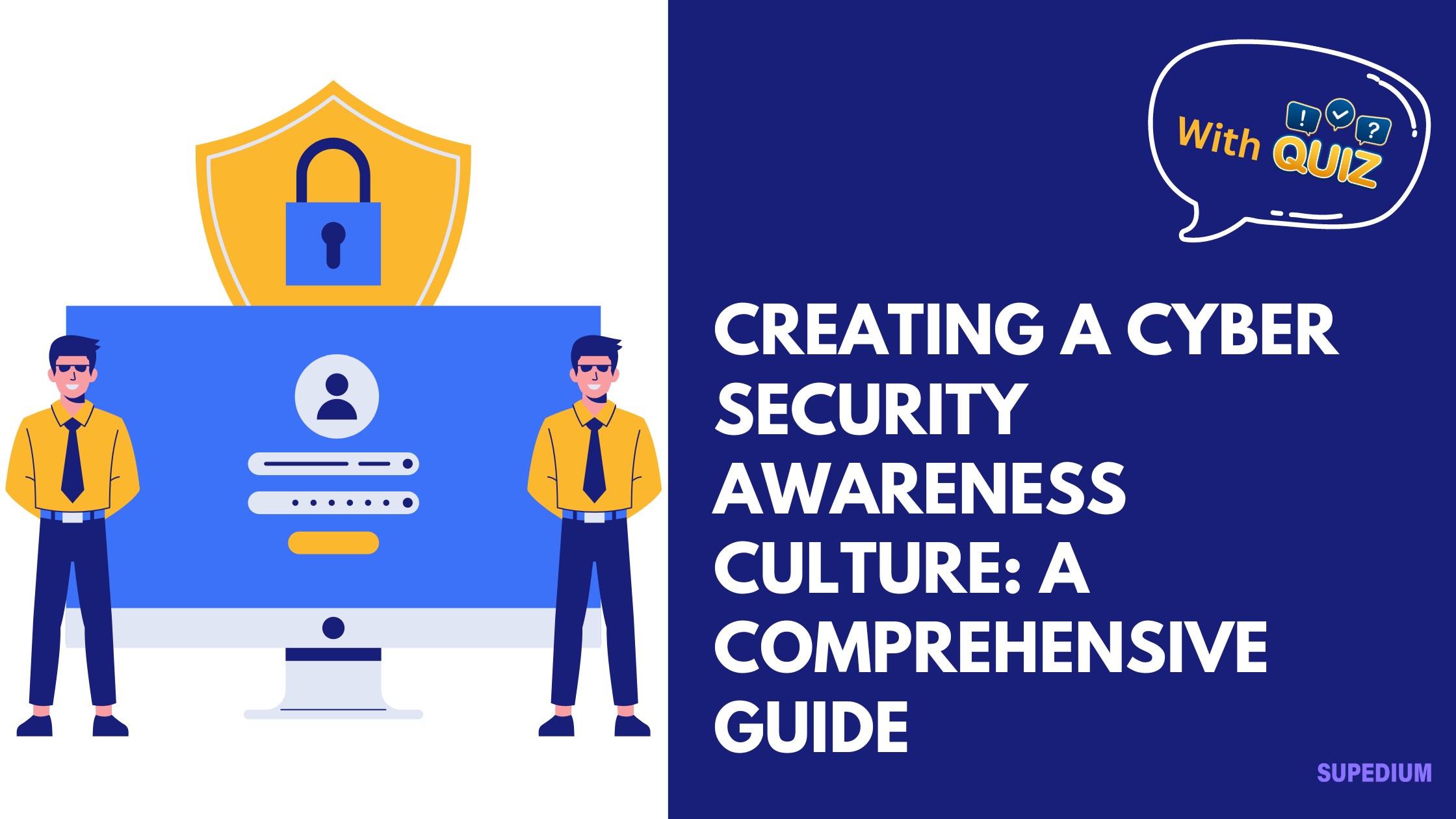Table of Contents
- 0.1 I. Introduction
- 0.2 II. Assessing Current Cyber Security Posture
- 0.3 III. Establishing a Cyber Security Awareness Program
- 0.4 IV. Implementing the Awareness Program
- 0.5 V. Encouraging Engagement and Participation
- 0.6 VI. Measuring and Evaluating Effectiveness
- 0.7 VII. Continuous Improvement and Adaptation
- 0.8 VIII. Case Studies and Best Practices
- 0.9 IX. Conclusion
- 1 Quiz Time
![]()
In today’s digital age, cyber security has become a critical concern for organizations of all sizes. The rise in cyber threats, ranging from phishing attacks to sophisticated ransomware, underscores the necessity of not only implementing robust security technologies but also cultivating a strong cyber security awareness culture within the organization. This article provides a comprehensive guide to creating and maintaining a cyber security awareness culture, ensuring that employees are well-informed and engaged in protecting the organization’s digital assets.
I. Introduction
Definition of Cyber Security Awareness Culture
A cyber security awareness culture refers to an environment in which all employees are knowledgeable about cyber threats and understand their role in protecting the organization’s digital resources. This culture goes beyond basic training; it integrates security awareness into everyday practices and decision-making processes.
Benefits of a Cyber Security Awareness Culture
- Reduces Risk of Cyber Attacks: An informed workforce is better equipped to recognize and respond to potential threats, reducing the likelihood of successful cyber attacks.
- Enhances Compliance with Regulations: Many regulations require organizations to provide security training and maintain awareness programs. A strong culture ensures compliance and mitigates legal risks.
- Protects Organizational Reputation: Organizations that proactively address cyber security are less likely to suffer reputational damage from data breaches or other security incidents.
II. Assessing Current Cyber Security Posture
Conducting a Risk Assessment
To build an effective cyber security awareness program, it’s essential first to understand the current security landscape. Conduct a comprehensive risk assessment to identify potential threats, vulnerabilities, and the effectiveness of existing security measures. This assessment helps prioritize areas that need improvement and focuses the awareness program on relevant issues.
Measuring Current Awareness Levels
Evaluate the current level of cyber security awareness among employees. Utilize surveys and assessments to gauge understanding and identify knowledge gaps. This baseline measurement is crucial for tailoring the training program to address specific needs and track improvements over time.
III. Establishing a Cyber Security Awareness Program
Defining Objectives and Goals
Clear objectives and goals are vital for a successful cyber security awareness program. Define what the program aims to achieve, such as reducing phishing susceptibility or improving incident reporting. Align these goals with the organization’s overall security strategy to ensure they address the most pressing needs.
Developing a Program Framework
Create a structured framework for the awareness program. This includes establishing policies and procedures that outline the program’s scope, content, and delivery methods. Identify key stakeholders, including IT professionals, human resources, and department heads, to ensure a collaborative approach to security.
Designing Training Content
Effective training content should cover the following areas:
- Basic Cyber Security Principles: Introduce fundamental concepts such as password management, data protection, and safe browsing practices.
- Specific Threats and Attack Vectors: Provide information on common threats like phishing, malware, and social engineering. Include real-world examples to illustrate these threats.
- Incident Response Procedures: Teach employees how to recognize and report security incidents. Ensure they understand the steps to take in the event of a breach or suspected attack.
IV. Implementing the Awareness Program
Selecting Training Methods
Choose a variety of training methods to cater to different learning styles:
- Online Courses and Modules: Offer interactive online courses that employees can complete at their own pace.
- In-Person Workshops and Seminars: Conduct face-to-face training sessions for hands-on learning and direct interaction with experts.
- Simulations and Role-Playing: Use simulated attacks and role-playing exercises to provide practical experience and reinforce learning.
Scheduling and Frequency
Develop a training schedule that includes:
- Initial Training Sessions: Provide comprehensive training for new hires and existing employees.
- Ongoing Refresher Courses: Schedule periodic refresher courses to keep employees updated on new threats and changes in security practices.
- Regular Updates on Emerging Threats: Share timely information about new and evolving threats to maintain awareness and preparedness.
Communication Strategies
Effective communication is crucial for reinforcing cyber security messages:
- Internal Newsletters and Bulletins: Use regular newsletters and bulletins to share security tips, updates, and best practices.
- Posters and Digital Signage: Place posters and digital signs in common areas to remind employees of key security practices.
- Interactive Platforms and Forums: Create online forums or chat groups where employees can discuss security issues and seek advice.
V. Encouraging Engagement and Participation
Incentivizing Participation
Encourage active participation through:
- Recognition Programs and Rewards: Acknowledge and reward employees who demonstrate exemplary security practices.
- Gamification and Competitions: Introduce gamified elements, such as quizzes and competitions, to make learning about cyber security engaging and fun.
Creating a Supportive Environment
Foster a culture of support and collaboration:
- Encouraging Open Communication: Promote an environment where employees feel comfortable discussing security concerns and reporting potential issues.
- Providing Access to Resources and Help: Ensure employees have access to resources such as help desks, FAQs, and contact points for security assistance.
Addressing Resistance and Challenges
Identify and address common barriers to engagement:
- Typical Challenges: Resistance may arise from lack of time, perceived irrelevance, or misunderstanding of the program’s importance.
- Strategies to Overcome Resistance: Communicate the personal and organizational benefits of the program clearly, and offer flexible training options to accommodate different schedules.
VI. Measuring and Evaluating Effectiveness
Monitoring Participation and Compliance
Track participation rates and compliance with training requirements. Use data to identify areas where engagement may be lacking and adjust the program accordingly.
Assessing Knowledge and Skills
Evaluate the effectiveness of the training through:
- Pre- and Post-Training Assessments: Measure knowledge before and after training sessions to gauge improvements.
- Simulation Exercises and Tests: Conduct simulations and tests to assess employees’ ability to apply what they’ve learned in real-world scenarios.
Gathering Feedback and Insights
Collect feedback from employees to gain insights into the program’s effectiveness:
- Employee Surveys and Interviews: Use surveys and interviews to gather opinions on the training content, delivery methods, and overall effectiveness.
- Analyzing Incident Reports and Trends: Review incident reports and trends to determine if the program has led to a reduction in security incidents.
VII. Continuous Improvement and Adaptation
Updating Training Content
Regularly update training materials to reflect new threats and changes in technology:
- Incorporating Feedback and Lessons Learned: Use feedback from employees and lessons learned from incidents to refine training content.
- Adapting to New Threats and Technologies: Stay informed about emerging threats and technological advancements to ensure the training remains relevant.
Revising Policies and Procedures
Review and revise security policies and procedures to align with current best practices and regulatory requirements:
- Reflecting Changes in the Threat Landscape: Update policies to address new and evolving threats.
- Ensuring Compliance with Regulations: Ensure policies comply with industry regulations and standards.
Enhancing Engagement Strategies
Continuously improve engagement strategies to maintain interest and participation:
- Implementing New Communication Methods: Explore new communication channels and techniques to keep the message fresh and engaging.
- Expanding Incentives and Recognition Programs: Introduce new ways to recognize and reward employees for their contributions to security.
VIII. Case Studies and Best Practices
Examples of Successful Cyber Security Awareness Programs
Review case studies of organizations with successful awareness programs:
- Overview of Industry Leaders: Highlight companies that have effectively implemented cyber security awareness programs and the strategies they used.
- Key Strategies and Takeaways: Discuss the key elements that contributed to their success and how they can be applied to other organizations.
Lessons Learned from Common Pitfalls
Identify and learn from common pitfalls encountered in cyber security awareness programs:
- Typical Challenges and Mistakes: Examine frequent issues such as lack of engagement, inadequate content, or inconsistent messaging.
- Solutions and Best Practices: Offer practical solutions and best practices to overcome these challenges and enhance the effectiveness of the program.
IX. Conclusion
Recap of Key Points
Creating a cyber security awareness culture is essential for protecting an organization’s digital assets. By assessing current security posture, establishing a comprehensive awareness program, implementing effective training, and continuously improving based on feedback and emerging threats, organizations can build a strong security culture.
Final Recommendations
Organizations should prioritize cyber security awareness as an ongoing commitment rather than a one-time initiative. Invest in regular training, foster a supportive environment, and remain adaptable to changing threats.
Call to Action for Organizational Leadership
Leaders should champion the cyber security awareness program, allocate necessary resources, and support continuous improvement efforts. By doing so, they can create a resilient organization that is well-prepared to face the evolving cyber threat landscape.






Be the first to comment